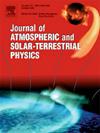Atmospheric infrasound disturbances during the large 2013 May 22 solar energetic particle event
IF 1.9
4区 地球科学
Q3 GEOCHEMISTRY & GEOPHYSICS
Journal of Atmospheric and Solar-Terrestrial Physics
Pub Date : 2025-06-02
DOI:10.1016/j.jastp.2025.106547
引用次数: 0
Abstract
The paper presents research on atmospheric infrasound disturbances during large solar energetic particle event on 2013 May 22. This event is remarkable for its interacting coronal mass ejections, which caused a high level of particle intensity, that reached the value of 2740 in the 1 MeV GOES energy channel respectively according to NOAA GOES data. The maximum energetic particle flux occurred at 08:20 UT on 05/23/2013 and about three hours after that, we registered the beginning of the daily cycle disturbance of natural atmospheric infrasound with a duration of up to 2 days and an increase in the magnitude of infrasound by 4 times. A probable mechanism of infrasound generation is proposed. The observed value of the time delay of infrasound arrival in relation to the moment of generation of energetic protons consists mainly of the infrasound propagation time from high latitudes to the observatory and is counted from the moment the peak flux of lower-energy protons arrives. It is found that before the disturbance, the spectrum of the atmospheric infrasound signal was dominated by oscillations with a period of s, while after the disturbance, the width of the infrasound frequency spectrum increased and oscillations with periods of s became dominant. The correlation of the proton flux density and the infrasound amplitude with the electric field strength in the surface atmosphere is revealed and explained.
2013年5月22日太阳高能粒子大事件期间的大气次声干扰
本文对2013年5月22日太阳高能大粒子事件中大气次声扰动进行了研究。该事件的显著特征是日冕物质抛射的相互作用,引起了高水平的粒子强度,根据NOAA GOES数据,在>;1 MeV GOES能量通道中,粒子强度分别达到2740 cm−2s−1sr−1。最大高能粒子通量出现在2013年05月23日08:20 UT,此后约3小时,我们记录到自然大气次声的日周期扰动开始,持续时间长达2天,次声强度增加了约3÷4倍。提出了一种可能的次声产生机制。次声到达时间延迟与高能质子产生时刻的观测值主要包括次声从高纬度到天文台的传播时间,从低能质子到达峰值时刻开始计算。研究发现,扰动前大气次声信号频谱以周期为T≈300 s的振荡为主,扰动后大气次声频谱宽度增大,周期为T≈100÷230 s的振荡为主。揭示并解释了表面大气中质子通量密度和次声振幅与电场强度的关系。
本文章由计算机程序翻译,如有差异,请以英文原文为准。
求助全文
约1分钟内获得全文
求助全文
来源期刊

Journal of Atmospheric and Solar-Terrestrial Physics
地学-地球化学与地球物理
CiteScore
4.10
自引率
5.30%
发文量
95
审稿时长
6 months
期刊介绍:
The Journal of Atmospheric and Solar-Terrestrial Physics (JASTP) is an international journal concerned with the inter-disciplinary science of the Earth''s atmospheric and space environment, especially the highly varied and highly variable physical phenomena that occur in this natural laboratory and the processes that couple them.
The journal covers the physical processes operating in the troposphere, stratosphere, mesosphere, thermosphere, ionosphere, magnetosphere, the Sun, interplanetary medium, and heliosphere. Phenomena occurring in other "spheres", solar influences on climate, and supporting laboratory measurements are also considered. The journal deals especially with the coupling between the different regions.
Solar flares, coronal mass ejections, and other energetic events on the Sun create interesting and important perturbations in the near-Earth space environment. The physics of such "space weather" is central to the Journal of Atmospheric and Solar-Terrestrial Physics and the journal welcomes papers that lead in the direction of a predictive understanding of the coupled system. Regarding the upper atmosphere, the subjects of aeronomy, geomagnetism and geoelectricity, auroral phenomena, radio wave propagation, and plasma instabilities, are examples within the broad field of solar-terrestrial physics which emphasise the energy exchange between the solar wind, the magnetospheric and ionospheric plasmas, and the neutral gas. In the lower atmosphere, topics covered range from mesoscale to global scale dynamics, to atmospheric electricity, lightning and its effects, and to anthropogenic changes.
 求助内容:
求助内容: 应助结果提醒方式:
应助结果提醒方式:


